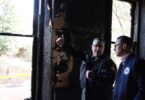Even when there is no immediate emergency, local first responders are hard at work practicing and drilling to work the kinks for responses to pressing emergencies that may happen in our communities.
Members of the Newtown Fire Association were on hand last Thursday evening while Langhorne-area fire departments and rescue squads practiced their response to the mock contamination of a university campus by a deadly chemical.
Langhorne Manor’s Cairn University hosted the drill, where first responders dealt with carfentanil, the deadly additive that can be found in some batches of heroin. Heroin with carfentanil can cause ill effects people who simply come into contact with it.
A major concern for first responders is they can be sickened just by coming in contact with heroin tainted with carfentanil.
About 20 students volunteered their time to give proper practice for local first responders. The drill consisted of the Langhorne-Middletown Fire Company, the Penndel Fire Company and the Penndel-Middletown Emergency Squad. Eight more emergency response organizations, including the Newtown Fire Association, were invited to observe the drill.
“We’re hoping for it to be a really effective learning experience,” said Frank Farry, the Fire Chief of the Langhorne-Middletown Fire Company. The responding personnel were tasked with identifying the harmful substance as carfentanil throughout their regular response efforts.
The choice to use carfentanil as the unknown substance came from Kevin Wagner, the training officer for the volunteer fire company. There have already been a few cases of carfentanil in the county, including one where four Newtown-area first responders were injured.
“We really need to be cautious with the protection we use,” Wagner said.
“It’s going to start affecting us on a regular basis,” the safety officer said, explaining his choice to go with carfentanil.
For the first responders on the scene, the drill consisted of arriving on the scene, evaluating the symptoms and levels of exposure for the victims, decontaminating the victims and giving the victims mock medical attention.
Of the more than 20 students of Cairn who volunteered their time, a bunch of students belong to the Cross Country team.
“It’s fun to see what actually happens in these cases and it is comforting to know that the first responders are going through this training,” explained Stephen Basile, a junior at Cairn University.
Taking notes, Farry watched the crews working to decontaminate the kids who may have been exposed to the faux chemical.
“The whole thing is a learning experience,” Farry said.
While his notepad contained things that responders could have done better, the point of these drills is to catch little mistakes so that they don’t happen during a real emergency, the fire chief and state representative said.
The entire drill took about six weeks of planning before coming to fruition.

















